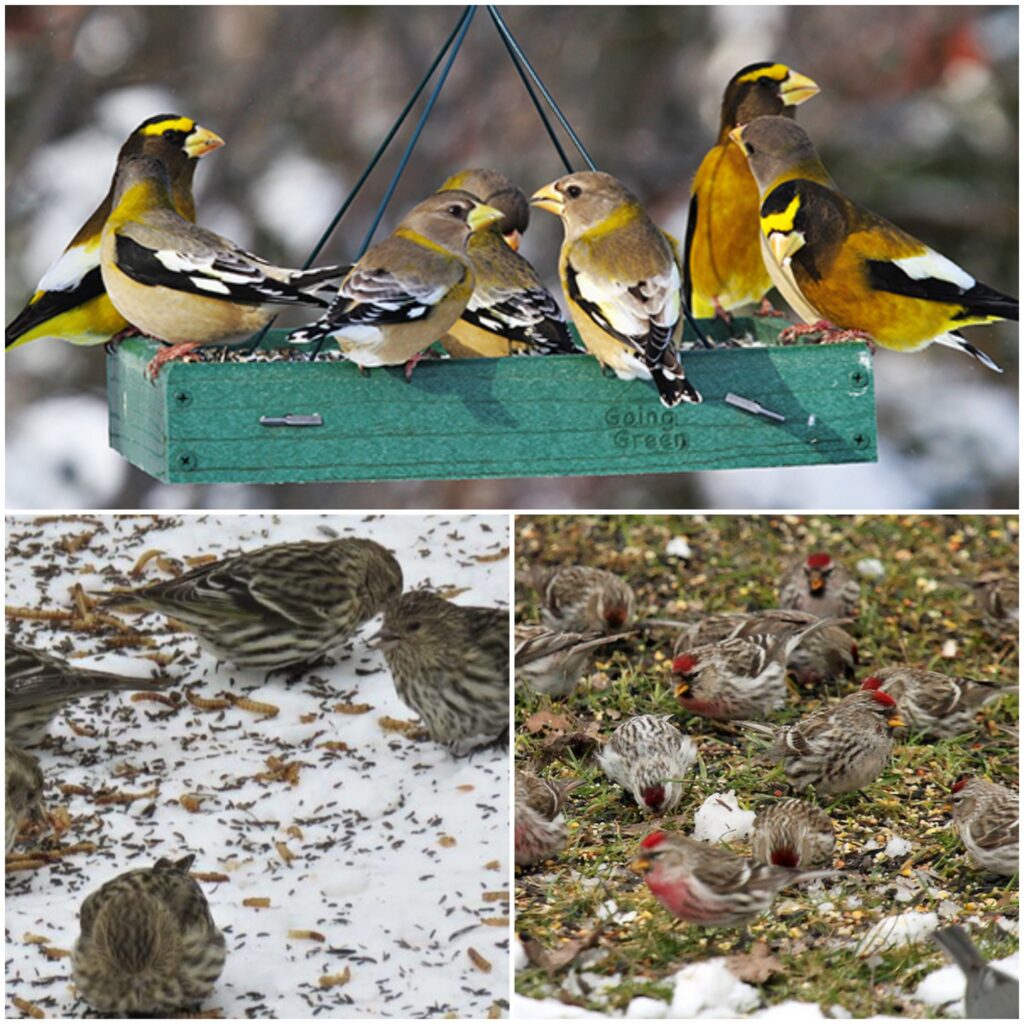Getting Acquainted With An Enigmatic Avian Nomad

Image By Cephas – Own work, CC BY-SA 3.0,
https://commons.wikimedia.org/w/index.php?curid=14587508
A vast array of avian wonders grace the North American continent. Some are seen by multitudes of folks in a wide variety of environments. Others are more reclusive, hiding from naturalists and bird watchers alike. Somewhere in the middle lies Hesperiphona vespertina — the evening grosbeak — a bird that you might see every day, or for a couple weeks every year, or for a few days every other year or — for the unfortunate — maybe not at all. These wonderful enigmas seem to captivate anyone who sees them, and they even have fan clubs among other bird species. Let’s explore.
Habitat and Range:
The Evening Grosbeak is primarily found in coniferous forests in north and western parts of North America. Its range extends from northeastern British Columbia and western Alberta in Canada, down through the Rocky Mountains and into the western United States. On the map at right (or below, on your personal mobile device), green represents its year-round range while winter quarters are in yellow.
Evening grossbeaks tend to prefer mature forests, particularly those with spruce, pine and fir trees. During the breeding season, however, they get a little more adventurous and often venture into deciduous woodlands. When I was growing up in Northern Wisconsin, our family home and lands were right on the border of their summer and winter ranges. We would see them for a week or so twice a year, although they didn’t keep much to a regular schedule. Their visits were always welcome, even if the flocks would go through more sunflower seeds in a week than most backyard birds do in a month.
One of the odd wonders of the evening grosbeak is the curious and dramatic increase in their range over the past 175 years. As late as the mid-1800s, they were rarely seen east of the Rocky Mountains and almost never east of the Mississippi. As masses of American settlers headed west, our enigmatic avian friends headed east. Reaching Rhode Island by 1910, evening grosbeaks were regular winter visitors throughout New England by the 1920. Researchers and ornithologists have some theories, but no solid answers for their bizarre expansive behavior.
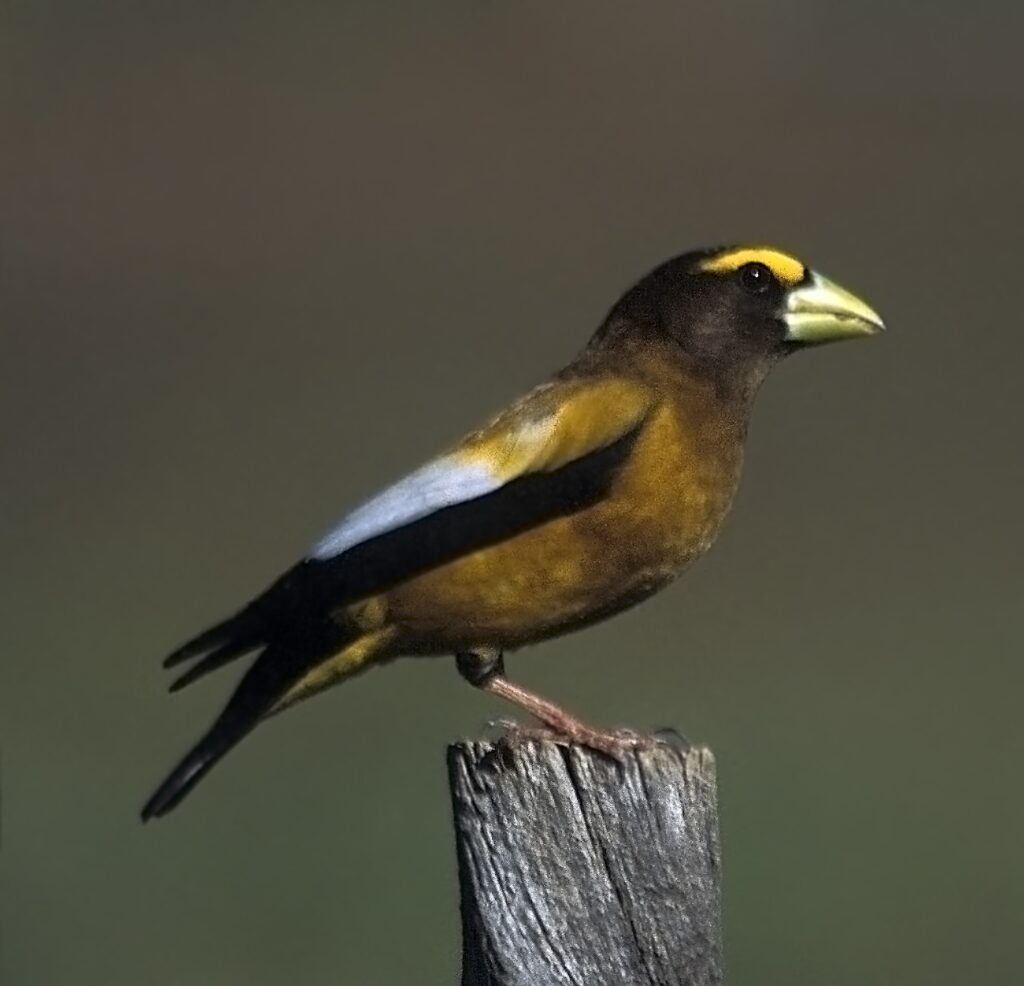
Image By Peter Wallack – Own work, CC BY-SA 3.0,
https://commons.wikimedia.org/w/index.php?curid=7505133
Size and Appearance
Sometimes referred to as “E-Gros,” evening grosbeaks are birds of striking appearance and medium size. They tend towards bulkiness and sport large bills, short tails and short legs. Adults are between six and eight inches tall with a wingspan up to 13 inches. Beaks are large and powerful, and bluish-gray or ivory in color.
As with many members of the finch family, their sexual dimorphism is more in color than in size. Typically, the males are bright and gaudy, while female colorization demonstrates tasteful understatement. Males have yellow foreheads and bodies, dark crowns with chocolate brown necks, and wings that display sharply contrasting black and white flight feathers.
Females are more muted but elegant in color, going about their business in subtle earth tones arranged in gentle but intricate patterns. The head and body are a soft grayish-brown, with a flash of yellow on the sides of the neck. Tail and wing feathers resemble those of the males but may show more shades of gray and white.

Photographer unknown; CC BY-SA 3.0,
https://commons.wikimedia.org/w/index.php?curid=1719933
What’s For Lunch? And Dinner? How About Dessert?
Evening Grosbeaks have a diverse diet that varies with the seasons. They primarily feed on seeds in the wild, particularly those from conifer trees like pines and spruces, and deciduous hardwoods such as ash and maple. When it’s time to feed the kids, however, their tastes tend to take a turn towards the carnivorous.

Image By Joanne Clifford – CC BY 2.0,
https://commons.wikimedia.org/w/index.php?curid=75394281
One of these birds’ most unique features is a powerful beak that crunches hard shells with ease. These relatively large seed-cracking wonders almost seem designed with sunflower seeds in mind. This is good since evening grosbeaks cannot seem to get enough of them. When flocks would make their somewhat irregular but always welcome visits to my childhood home, they could go through three 20-lb bags of sunflowers in a week.
Remember what I said about having fan clubs from other bird species? Believe it or not, it’s their voracious eating habits that make them popular. The beaks of common redpolls and pine siskins are too small to crack hickory and beech nuts — as well as larger sunflower seeds — so they often follow flocks of evening grosbeaks to take advantage of their voracious and somewhat sloppy eating habits. Smaller bird species are a frequent sight on the ground when their larger avian relatives take over any and all elevated and hanging bird feeders.
Amusingly — and of course enigmatically — it seems that at least a few evening grosbeaks in some areas may have developed a bit of a sweet-tooth. Or they might have, if they actually had teeth. So maybe it’s a “sweet-beak?”
No. Definitely not. Let’s forget I even said that.
Anyway…
As background, sap from maple trees contains mostly water. Unlike most other trees, however, maple sap — especially from black and sugar maples — is about two percent sugar: mostly sucrose, with smaller levels of fructose and glucose. For the four species of North American sapsucker — and to a lesser extent, several species of their close relative woodpeckers — drilling out and consuming sweet maple sap is a regular spring ritual. There are a number of other species — hummingbirds, warblers and nuthatches, for example — that hang around sugar maple trees waiting to clean up after sapsuckers, squirrels and porcupines.
Lacking the exceptionally strong neck muscles and reinforced skulls of woodpeckers, a few of our clever, enigmatic avian adventurers seem to have developed their own system. Completely ignoring the main tree-trunk where woodpeckers typically do their banging, evening grosbeaks focus on twigs and smaller, younger branches which still retain smoother bark. They use their impressive beaks to peel the bark right off the wood and expose the sap underneath. Enigmatic and efficient — since the sap extraction happens in the spring — evening grosbeaks use the peeled bark in building the new family nest. Isn’t that sweet?
It should be noted that the E-Gros maple sap harvest has only been observed and documented in a few isolated instances. Therefore, it should not be considered a regular behavior pattern of the evening grosbeak. Perhaps someday, expanded research will shed more light on the sweet spring sugar rush. In the meantime, let’s hope that avian diabetes doesn’t become a thing with non-domestic birds.

Images Are In the Public Domain via Wikimedia Commons Or Courtesy of
The Cornell University Lab of Ornithology’s Macaulay Library
Buds, berries and small fruits are also on the menu for the evening grosbeak. They are one of the only birds with beaks strong enough to crack open cherry pits. Mountain ash berries and the samara — or “helicopter” — seeds from maple trees and the related box elder are also dietary staples. Based on the sheer volume of photographs I encountered of E-Gross in sumac trees (see collages above and below) while I was doing research, apparently they’re also extremely fond of staghorn sumac seeds — technically called “drupes.”

Images Are In the Public Domain via Wikimedia Commons Others are Courtesy of The Vermont Birder
And insects become the main course during the breeding season, when the high protein needs of the nestlings dictate the family diet. Although we lack reliable scientific research on the topic, anecdotal evidence suggests a great fondness for the pestilent and destructive spruce budworm. Maybe fir tree fan clubs are in the evening grosbeak’s future? Ok, probably not.
Of Family Matters And Hidden Nests
Breeding season begins in the early spring for the serially monogamous evening grosbeak. A male will put on a courtship display and may demonstrate his food-getting prowess until a female decides he might be up to the task. Specifics of their nesting location preferences is another enigma. For a variety of reasons — some obvious, some mysterious — their nests are relatively difficult to locate. Apparently they’re even harder to capture with a camera, since coming up an authentic photograph of an evening grosbeak nest proved next-to-impossible for me.
The male may take the lead or the couple may cooperate in selecting a nesting spot, often on a horizontal branch in the upper reaches of a coniferous tree, sometimes adjacent to the trunk. It appears that the female does most of the nest-building work while the male supervises and occasionally helps gather materials — twigs, grasses, moss, and other plant materials.

Image By Bettina Arrigoni NM|2019-07-15|12-28-28-2, CC BY 2.0, https://commons.wikimedia.org/w/index.php?curid=82943398
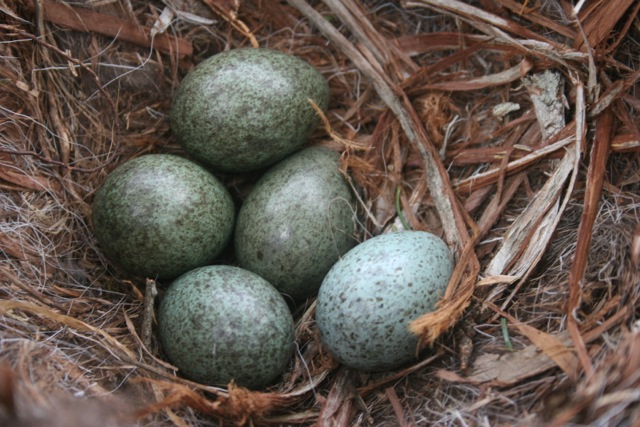
Courtesy of The Naturalist’s Notebook
Once construction is finished, three to five blue-green eggs with brown or purple markings are laid. Incubation lasts 12-14 days and is done mostly by the female. The male may occasionally take a turn sitting but mostly sticks to bringing the female food.
Both parents are believed to play active roles in feeding the nestlings, primarily providing them with a diet rich in insect protein. The fledging period — when the young birds develop flight feathers — spans two or three weeks.
After that, the fledglings leave the nest but continue to receive parental care and guidance for another month or so.
Migratory or Not?
Although classified as migratory, their traveling habits are irregular and unpredictable at best. Typical migratory birds follow regular routes and consistent schedules, but evening grosbeaks will have none of that! Sometimes they seem to react to the weather. Other times they appear to follow food sources.
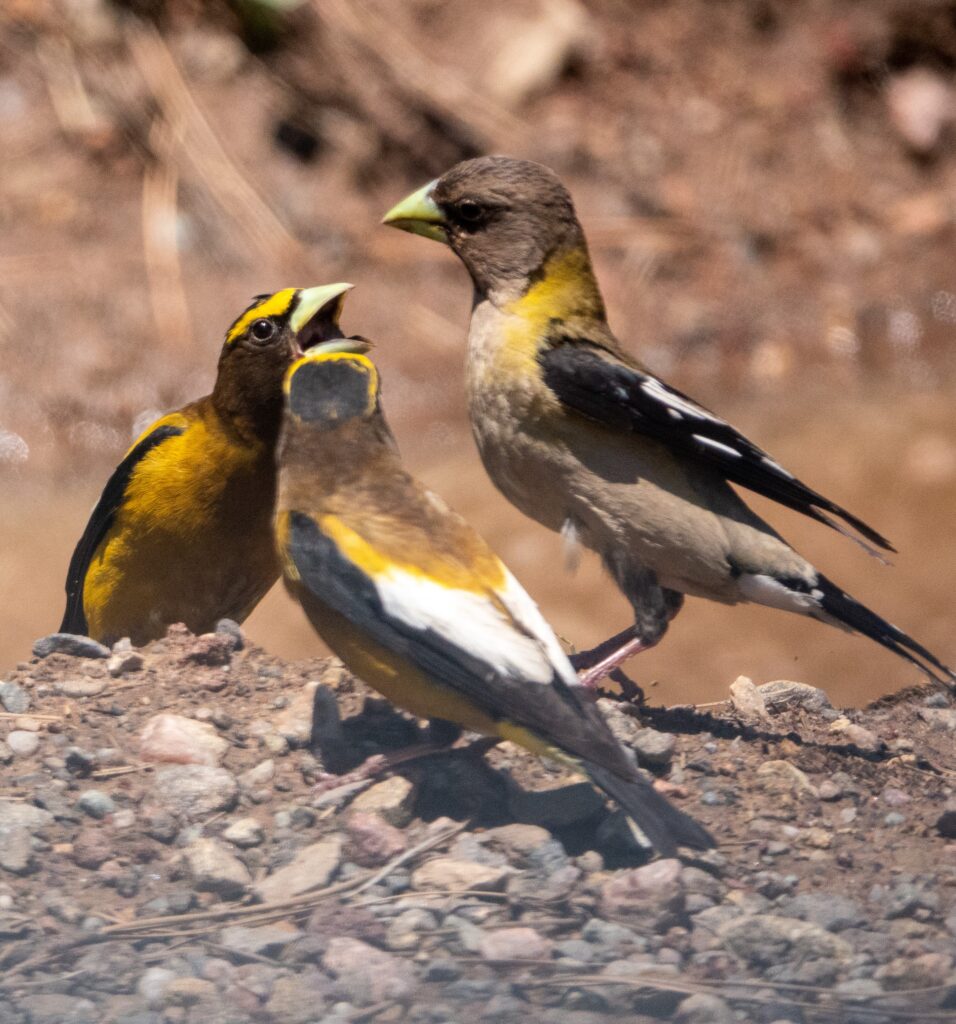
By Bettina Arrigoni – Evening Grosbeak NM|2019-07-15|12-28-00, CC BY 2.0, https://commons.wikimedia.org/w/index.php?curid=82943401
Sometimes they will nest in the same area as the previous year, while other times they may head to a completely different state. Oftentimes, if there’s a reason for where they go and when, they sure haven’t told scientific researchers yet. Ornithologists call such behavior “irruptive migration,” but I think I’ll stick with “enigmatic.” It seems a better fit for their personalities.
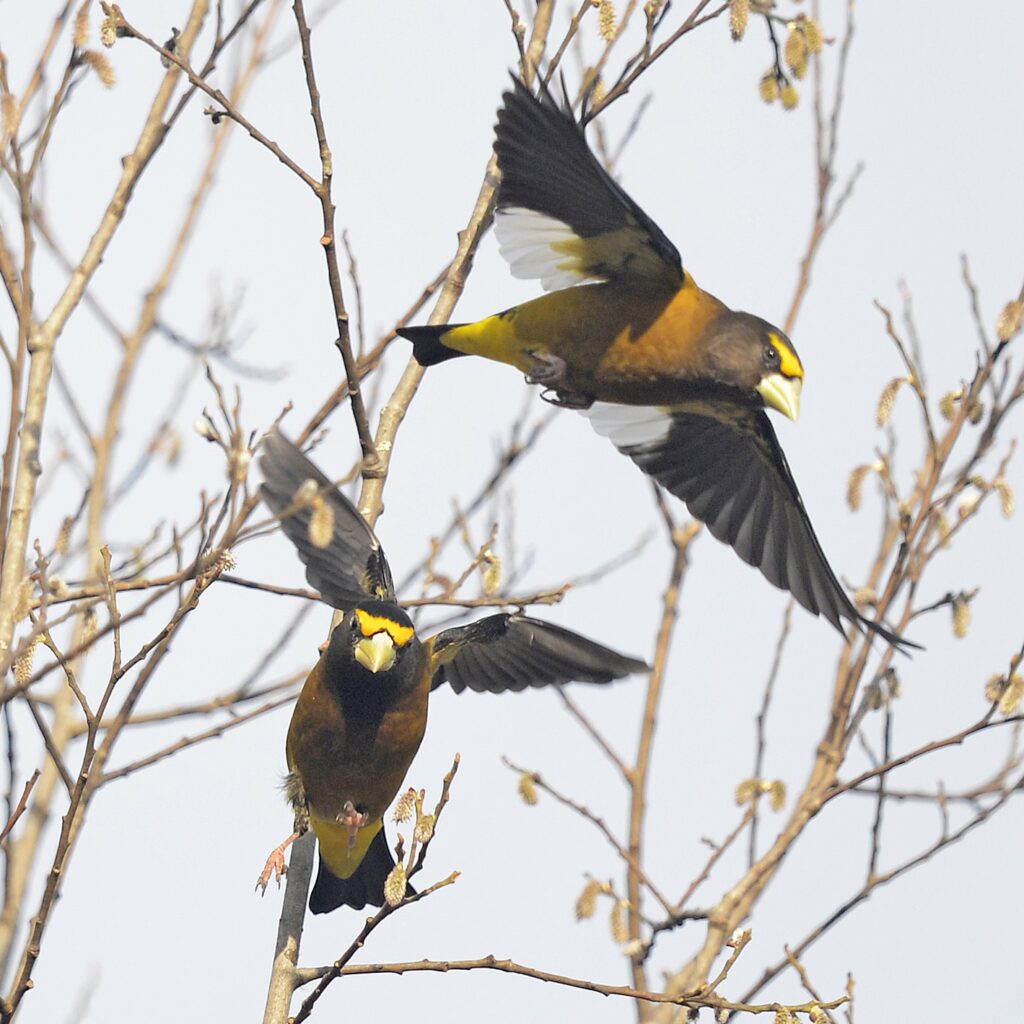
Image By Vickie J Anderson – Own work, CC BY-SA 4.0,
https://commons.wikimedia.org/w/index.php?curid=135502900
* * * * * * * * * * * * * * *
So there you have it. Elusive, enchanting, and yes, enigmatic. The evening grosbeak captivates experienced bird-watchers and casual observers alike. I covered some of the basics here in Part I. Next week, Part II will touch on related folklore, spotting them in the wild and attracting them to your yard. We may even wade into the debate over whether or not these “songbirds” actually sing anything worth hearing. (Spoiler alert: I love ‘em, but oh, heck no!) Until then, cheers to the birds!
By Steven Roberts


